This is an old revision of this page, as edited by ElinorD (talk | contribs) at 20:40, 21 January 2007 (→Marriage and family: I don't really like "found a husband". It's like "caught a man".). The present address (URL) is a permanent link to this revision, which may differ significantly from the current revision.
Revision as of 20:40, 21 January 2007 by ElinorD (talk | contribs) (→Marriage and family: I don't really like "found a husband". It's like "caught a man".)(diff) ← Previous revision | Latest revision (diff) | Newer revision → (diff)- For other people named Martin Luther, see Martin Luther (disambiguation).
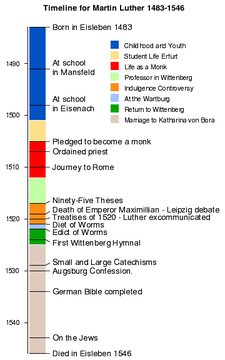
Early life
In 1501, at the age of seventeen, Luther entered the University of Erfurt where he played the lute and was nicknamed "the philosopher." He received a B.A. in 1502 and an M.A. in 1505, placing second out of seventeen candidates. In accordance with his father's wishes, Luther enrolled in the law school at the same university.
According to Luther, the course of his life changed during a thunderstorm in the summer of 1505. A lightning bolt struck near him as he was returning to school. Terrified, he cried out, "Help! Saint Anna, I'll become a monk!" He left law school, sold his books, and entered the Augustinian monastery in Erfurt on July 17, 1505.
Monastic and academic life
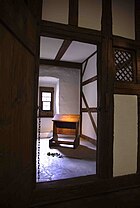
Luther dedicated himself to monastic life, devoting himself to fasts, long hours in prayer and pilgrimage, and frequent confession. Luther tried to please God through this dedication, but it only increased his awareness of his own sinfulness. He would later remark, "If anyone could have gained heaven as a monk, then I would indeed have been among them." Luther described this period of his life as one of deep spiritual despair. He said, "I lost hold of Christ the Savior and Comforter and made of him a stock-master and hangman over my poor soul."
Johann von Staupitz, Luther's superior, concluding that the young monk needed more work to distract him from excessive introspection ordered him to pursue an academic career. In 1507 he was ordained to the priesthood, and in 1508 began teaching theology at the University of Wittenberg. He received a Bachelor's degree in Biblical studies on March 9, 1508, and another Bachelor's degree in the Sentences by Peter Lombard in 1509. On October 19, 1512, he was awarded his Doctor of Theology and, on October 21, 1512, was received into the senate of the theological faculty of the University of Wittenberg, having been called to the position of Doctor in Bible. He spent the rest of his career in this position at the University of Wittenberg.
Justification by faith

- Main article: Theology of Martin Luther
From 1510 to 1520, Luther lectured on the Psalms, the books of Hebrews, Romans and Galatians. As he studied these portions of the Bible, he came to understand terms such as penance and righteousness in new ways. He began to teach that salvation is a gift of God's grace in Christ received by faith alone. The first and chief article is this, Luther wrote, "Jesus Christ, our God and Lord, died for our sins and was raised again for our justification… herefore, it is clear and certain that this faith alone justifies us… Nothing of this article can be yielded or surrendered, even though heaven and earth and everything else falls."
The 95 Theses
Main article: The 95 ThesesOn 31 October 1517 Luther wrote to Albert, Archbishop of Mainz and Magdeburg, protesting the sale of indulgences in his episcopal territories and inviting him to a disputation on the matter. He enclosed the 95 Theses, a copy of which, according to tradition, he posted the same day on the door of the Castle Church in Wittenberg.
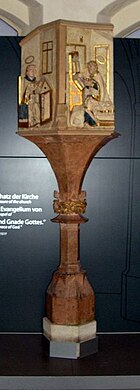
While Luther did not deny the pope’s right to grant pardons for penance imposed by the Church, he made it clear that preachers who claimed that indulgences absolved buyers from all punishments and granted them salvation were in error. The final two theses exhorted Christians not to slacken in following Christ, but to be confident of entering heaven through many tribulations rather than through an assurance of peace.
The 95 Theses were quickly translated into German, printed, and widely copied, making the controversy one of the first in history to be fueled by the printing press. Within two weeks, the theses had been translated into German and spread throughout Germany; within two months throughout Europe. In contrast, the response of the papacy was painstakingly slow.
Response of the papacy

Cardinal Albert of Hohenzollern, Archbishop of Mainz and Magdeburg, with the consent of Pope Leo X, was using part of the indulgence income to pay his bribery debts, and did not reply to Luther’s letter; instead, he had the theses checked for heresy and forwarded to Rome.
Leo responded over the next three years, “with great care as is proper”, by deploying a series of papal theologians and envoys against Luther. Perhaps he hoped the matter would die down of its own accord, because in 1518 he dismissed Luther as "a drunken German" who "when sober will change his mind".
Widening breach

Luther's writings circulated widely, soon reaching France, England, and Italy as early as 1519. Students thronged to Wittenberg to hear Luther. He published a short commentary on Galatians and his Work on the Psalms. At the same time, he received deputations from Italy and from the Utraquists of Bohemia. Ulrich von Hutten and knight Franz von Sickingen offered to place Luther under their protection.
This period of Luther's career was one of the most creative and productive. Three of Luther's best known works were published in 1520: To the Christian Nobility of the German Nation, Prelude on the Babylonian Captivity of the Church and Freedom of a Christian.
Excommunication and Diet of Worms
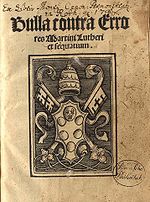
On June 15, 1520, the Pope warned Martin Luther with the papal bull Exsurge Domine that he risked excommunication unless he recanted 41 sentences drawn from his writings within 60 days.
That autumn, Johann Eck proclaimed the bull in Meissen and other towns. Miltitz attempted to broker a solution; but Luther, who sent the pope a copy of On the Freedom of a Christian in October, publicly set fire to the bull and decretals at Wittenberg on December 10 1520, an act he defended in Why the Pope and his Recent Book are Burned and Assertions Concerning All Articles. Luther was finally excommunicated by Leo X on January 3, 1521, in the bull Decet Romanum Pontificem.
Enforcement of the ban now fell to the secular authorities. Luther appeared, as ordered, on April 17, 1521, before the Diet of Worms, which Emperor Charles V had opened on January 22. Johann Eck, speaking on behalf of the empire as assistant of the Archbishop of Trier, presented Luther with a table filled with copies of his writings and asked him if the books were his and if he still taught what they contained. Luther requested time to think about his answer, which was granted. Luther prayed, consulted with friends and mediators and gave his response to the diet the next day:
Unless I shall be convinced by the testimonies of the Scriptures or by clear reason … I neither can nor will make any retraction, since it is neither safe nor honourable to act against conscience. God help me. Amen.
Over the next five days, private conferences were held to determine the fate of Luther, who left Worms on 26 April. The emperor presented the final draft of the Edict of Worms on May 25, 1521, declaring Martin Luther an outlaw, banning his literature, and requiring his arrest: "We want him to be apprehended and punished as a notorious heretic".
Exile at the Wartburg Castle

The Emperor had granted Luther a safe-conduct for his return to Wittenberg by the safe-conduct. Frederick the Wise, who had arranged for Luther's safe-conduct, arranged for him to be taken into safe custody on his way home by a company of masked horsemen and carried to Wartburg Castle at Eisenach, where he stayed for about a year. He grew a beard and wore the closing of a knight, and assumed the pseudonym Junker Jörg (Knight George).
His time at the Wartburg was another productive period in his career. Luther translated the New Testament from Greek into German. It was printed in September 1522. He issued an essay on the practice of Confession Concerning Confession, in which he rejected laws by the church, forcing people to go to private confession, although he affirmed the value of private confession and absolution.
Return to Wittenberg

Around Christmas 1521 Anabaptists from Zwickau entered Wittenberg and caused considerable civil unrest. Thoroughly opposed to their radical views and fearful of their results, Luther secretly returned to Wittenberg on March 6, 1522, and the Zwickau prophets left the city. For eight days in Lent beginning on March 9, Invocavit Sunday, and concluding on the following Sunday, Luther preached eight sermons that would become known as the Invocavit Sermons. In these sermons Luther counseled careful reform that took into consideration the consciences of those who were not ready or willing yet to embrace reform. Luther took great concern to protect the faith of the most fragile believer insisting that what carried the gospel to them must not be taken away by his fellow reformers. Luther worked patiently to reintroduce the practice of receiving Holy Communion in both kinds, that is, receiving both the consecrated bread and wine, rather than the practice of denying the wine to lay people. The canon of the mass, giving it its sacrificial character, was now omitted. Since the former practice of penance had been abolished, communicants were now required to declare their intention to commune and to seek consolation in Christian confession and absolution. This new form of service was set forth by Luther in his Formula missæ et communionis (Form of the Mass and Communion, 1523), and in 1524 the first Wittenberg hymnal appeared with four of his own hymns, including A Mighty Fortress and the first hymn he wrote for congregational singing, Dear Christians One and All Rejoice. Since, however, his writings were forbidden in that part of Saxon ruled by Duke George, Luther declared, in his Temporal Authority: to What Extent It Should Be Obeyed, that the civil authority could enact no laws for the soul.
Marriage and family
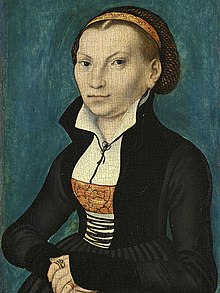
On April 8, 1523, Luther wrote to Wenceslaus Link: "Yesterday I received nine nuns from their captivity in the Nimbschen convent." Luther had arranged for Torgau burgher Leonhard Koppe on April 4 to assist twelve nuns to escape from the Cistercian monastery in Nimbschen near Grimma in Ducal Saxony. Koppe transported them out of the convent in herring barrels. Three of the nuns went to be with their relatives, leaving the nine that were brought to Wittenberg, one of whom was Katharina von Bora. All except Katharina were married shortly afterwards. In May and June 1523, it was thought that she might marry a Wittenberg University student, Jerome Paumgartner, but his family most likely prevented it. Dr. Caspar Glatz was the next prospective husband put forward, but Katharina had "neither desire nor love" for him. She made it known that she wanted to marry either Luther himself or Nicholas von Amsdorf. Luther did not feel that he was fit to be a husband considering his excommunication by the pope and outlawed by the emperor. In May or early June 1525, it became known in Luther's circle that he intended to marry Katharina. Forestalling any objections from friends against Katharina, Luther acted quickly. On the evening of Tuesday, June 13, 1525, Luther and Katharina married. Luther affectionately called her "Katy". Over the years they had six children, three boys and three girls, and lived in Luther's former Augustianian monastery in Wittenberg which had been given to Luther by the Elector as a home.
Peasants' War
The Peasants' War (1524–25) was in many ways a response to the preaching of Luther and others. Revolts by the peasantry had existed on a small scale since the 14th century, but many peasants mistakenly believed that Luther's attack on the Church and the hierarchy meant that the reformers would support an attack on the social hierarchy as well, because of the close ties between the secular princes and the princes of the Church that Luther condemned. Revolts that broke out in Swabia, Franconia, and Thuringia in 1524 gained support among peasants and disaffected nobles, many of whom were in debt. Gaining momentum and a new leader in Thomas Münzer, the revolts turned into an all-out war, the experience of which played an important role in the founding of the Anabaptist movement. Initially, many thought Luther supported the peasants, condemning the oppressive practices of the nobility that had incited them to revolt. As the war continued, and especially as atrocities at the hands of the peasants increased, the revolt became an embarrassment to Luther, who strongly condemned the peasants. In Against the Murderous, Thieving Hordes of Peasants (1525), he encouraged the nobility to crush the revolt. Many of the revolutionaries considered Luther's words a betrayal. Others withdrew once they realized that there was neither support from the Church nor from its main opponent. The war in Germany ended in 1525 when rebel forces were destroyed by the armies of the Swabian League.
Catechisms
In 1528 Luther took part in a formal visit of parishes and schools in Saxony to determine the quality of pastoral care and Christian education the people were receiving. Luther wrote in the preface to the Small Catechism,
Mercy! Good God! what manifold misery I beheld! The common people, especially in the villages, have no knowledge whatever of Christian doctrine, and, alas! many pastors are altogether incapable and incompetent to teach.
In response, Luther prepared the Small and Large Catechisms. They are instructional and devotional material on the Ten Commandments; the Apostles' Creed; the Lord's Prayer; Baptism; Confession and Absolution; and the Lord's Supper. The Small Catechism was supposed to be read by the people themselves, the Large Catechism by the pastors. Luther, who was modest about the publishing of his collected works, thought his catechisms were one of two works he would not be embarrassed to call his own:
Regarding to collect my writings in volumes, I am quite cool and not at all eager about it because, roused by a Saturnian hunger, I would rather see them all devoured. For I acknowledge none of them to be really a book of mine, except perhaps the one Bondage of the Will and the Catechism.
The two catechisms are still popular instructional materials among Lutherans.
Luther's German Bible
Main article: Luther Bible
Luther translated the Bible into German to make it more accessible to the common people, a task he began alone in 1521 during his stay in the Wartburg castle, publishing The New Testament in September 1522 and, in collaboration with Johannes Bugenhagen, Justus Jonas, Caspar Creuziger, Philipp Melanchthon, Matthäus Aurogallus, and George Rörer, the whole Bible in 1534. He worked on refining the translation for the rest of his life. The Luther Bible contributed to the emergence of the modern German language and is regarded as a landmark in German literature. The 1534 edition was also profoundly influential on William Tyndale's translation, a precursor of the King James Bible.
Liturgy and Church government
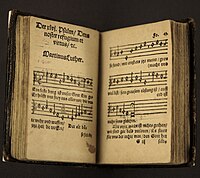
Martin Luther’s German Mass of 1526 provided for weekday services and for catechetical instruction. He strongly objected, however, to making a new law of the forms and urged the retention of other good liturgies. While Luther advocated Christian liberty in liturgical matters in this way, he also spoke out in favor of maintaining and establishing liturgical uniformity among those sharing the same faith in a given area. He saw in liturgical uniformity a fitting outward expression of unity in the faith, while in liturgical variation, an indication of possible doctrinal variation. He did not consider liturgical change a virtue, especially when it might be made by individual Christians or congregations: he was content to conserve and reform what the Church had inherited from the past. Therefore Luther, while eliminating and condemning those parts of the mass that taught that the Eucharist was a propitiatory sacrifice and the Body and Blood of Christ by transubstantiation, retained the use of historic liturgical forms and customs.
Eucharist controversy
Martin Luther's views on the Eucharist, the sacrament of the Lord's Supper, were put to the test in October 1529 at the Marburg Colloquy, an assembly of Protestant theologians gathered by Philip I, Landgrave of Hesse, to establish doctrinal unity in the emerging Protestant states. Agreement was achieved on most points, the exception being the nature of the Eucharist, an issue crucial to Luther.
The theologians, including Zwingli, Karlstadt, Jud, and Œcolampadius, differed among themselves on the significance of the words of institution spoken by Jesus at the Last Supper: "This is my body which is for you", "This cup is the new covenant in my blood" (1 Corinthians 11:23–26). Luther insisted on the Real Presence of Jesus at the Eucharist, but the other theologians believed God to be only symbolically present: Zwingli, for example, denied Jesus's ability to be in more than one place at a time. But Luther, who affirmed the doctrine of Hypostatic Union, that Jesus is one and the same as God, was clear:
For I do not want to deny in any way that God’s power is able to make a body be simultaneously in many places, even in a corporeal and circumscribed manner. For who wants to try to prove that God is unable to do that? Who has seen the limits of his power?
Despite these disagreements on the Eucharist, the Marburg Colloquy paved the way for the signing in 1530 of the Augsburg Confession and for the formation of the Schmalkaldic League the following year by leading Protestant nobles such as Philip of Hesse, John Frederick of Saxony, and George, Margrave of Brandenburg-Ansbach. Nevertheless, interpretations of the Eucharist differ among Protestants to this day.
Augsburg Confession
Main article: Augsburg Confession
Charles V, the Holy Roman Emperor, convened an Imperial Diet in Augsburg in 1530 with the goal of uniting the empire against the Ottoman Turks, who had besieged Vienna the previous autumn.
To achieve unity, Charles required a resolution of the religious controversies in his realm. Luther, still under the Imperial Ban, was left behind at the Coburg fortress while his elector and colleagues from Wittenberg attended the diet. The Augsburg Confession, a summary of the Lutheran faith authored by Philipp Melanchthon but influenced by Luther, was read aloud to the emperor. It was the first specifically Lutheran confession included in the Book of Concord of 1580, and is regarded as the principal confession of the Lutheran Church.
Luther and anti-Semitism
- See also: Martin Luther and the Jews and On the Jews and Their Lies
In his treatise, On the Jews and Their Lies, published in 1543 as Von den Juden und ihren Lügen, Luther wrote "set fire to their synagogues or schools and to bury and cover with dirt whatever will not burn, so that no man will ever again see a stone or cinder of them...I advise that their houses also be razed and destroyed...their prayer books and Talmudic writings, in which such idolatry, lies, cursing and blasphemy are taught, be taken from them....their rabbis be forbidden to teach henceforth on pain of loss of life and limb....that safe-conduct on the highways be abolished completely for the Jews. For they have no business in the countryside, since they are not lords, officials, tradesmen, or the like. Let them stay at home....that usury be prohibited to them, and that all cash and treasure of silver and gold be taken from them and put aside for safekeeping...I commend putting a flail, an ax, a hoe, a spade, a distaff, or a spindle into the hands of young, strong Jews and Jewesses and letting them earn their bread in the sweat of their brow, as was imposed on the children of Adam..." and recommended that these "poisonous envenomed worms" be forced into labor or expelled "for all time."
There is little doubt among historians that Luther's rhetoric may have contributed to, or at the very least foreshadowed, the actions of the Nazis when Adolf Hitler came to power in Germany in 1933, although the extent to which it played a direct role in the events leading to the Holocaust is debated. At the heart of the debate is whether it is anachronistic to view Luther's sentiments as an example, or early precursor, of racial anti-Semitism — hatred toward the Jews as a people — rather than anti-Judaism — contempt for Judaism as a religion.
A minority viewpoint disagrees with the attempt to link Luther's work causally to the rise of Nazi anti-Semitism, arguing that it is too simplistic an analysis. Some Lutheran church bodies have distanced themselves from this aspect of Luther's work. In 1983, the Lutheran Church - Missouri Synod, denounced Luther's "hostile attitude" toward the Jews. In 1994, the Church Council of the Evangelical Lutheran Church in America announced: "As did many of Luther's own companions in the sixteenth century, we reject this violent invective, and yet more do we express our deep and abiding sorrow over its tragic effects on subsequent generations."
Luther on witchcraft and magic
Luther shared the belief that witchcraft existed and was inimical to Christianity. While Luther did not specifically write about witchcraft, his ideas of it are available through discussions of Biblical references to witchcraft and in table talk. His ideas were similar to those of late medieval Christian thinkers. Luther shared some of the superstitions about witchcraft that were common in his time. When interpreting Exodus 22:18, Luther stated that witches with the help of the devil could steal milk simply by thinking of a cow.
In his Small Catechism, Luther taught that witchcraft was a sin against the second commandment and prescribed the Biblical penalty for it in a "table talk":
On 25 August 1538 there was much discussion about witches and sorceresses who steal chicken eggs out of nests, or steal milk and butter. Doctor Luther said: "One should show no mercy to these ; I would burn them myself, for we read in the Law that the priests were the ones to begin the stoning of criminals."
Final years
Main article: Last days of Martin LutherDuring the later years of his life, Luther remained busy and active lecturing at the university on the Biblical book of Genesis, serving as dean of the theological faculty, and making many visitations to churches. During the final nine years of his life Luther wrote 165 treatises and nearly ten letters a day, examined many candidates for doctoral degrees in theology and hosting doctoral feasts for the successful candidates. His later years were marked by continuing illnesses and physical problems, making him short-tempered and even more pointed and harsh in his writings and comments. His wife Katie was overheard saying, "Dear husband, you are too rude," and he responded, "They teach me to be rude."
Luther's final journey, to Mansfeld, was taken due to his concern for his siblings' families continuing in their father Hans Luther's copper mining trade. Their livelihood was threatened by Count Albrecht of Mansfeld bringing the industry under his own control. Luther journeyed to Mansfeld twice in late 1545 to participate in the negotiations for a settlement, and a third visit was needed in early 1546 for their completion.
The negotiations were successfully concluded on February 17. After 8:00 p.m. that day, Luther experienced chest pains. He died 2:45 a.m., February 18, 1546, aged 62, in Eisleben, the city of his birth. Luther was buried in the Castle Church in Wittenberg, beneath the pulpit.
References
- Ewald Plass, "Monasticism", in What Luther Says: An Anthology (St. Louis: Concordia Publishing House, 1959), 2:964.
- Erwin Fahlbusch and Geoffrey William Bromiley, The Encyclopedia of Christianity (Grand Rapids, MI: Leiden, Netherlands: Wm. B. Eerdmans; Brill, 1999–2003), 1:244.
- ^ Tyndale's New Testament, trans. from the Greek by William Tyndale in 1534 in a modern-spelling edition and with an introduction by David Daniell (New Haven, CT: Yale University Press, 1989), ix–x.
- Jacques Barzun, From Dawn to Decadence (New York: Harper Collins, 2000), 4.
- "The last and greatest reform of all was in congregational song. In the Middle Ages the liturgy was almost entirely restricted to the celebrant and the choir. The congregation joined in a few responses in the vernacular. Luther so developed this element that he may be considered the father of congregational song." from Roland Bainton, Here I Stand: a Life of Martin Luther (New York: Penguin, 1995), 269; Martin Luther, Luther: Hymns, Ballads, Chants, Truth (4 compact disks). St. Louis: Concordia Publishing House, 2005.
- "If he could not reform all Christendom, at any rate he could and did establish the protestant parsonage" from Bainton, 223.
- Lutheran World Federation, "Slight Increase Pushes LWF Global Membership to 66.2 Million", The Lutheran World Federation, accessed May 18 2006.
- "Major Branches of Religions Ranked by Number of Adherents", (accessed May 22 2006).
- Martin Luther, "On the Jews and Their Lies," Tr. Martin H. Bertram, in Luther's Works ed. Franklin Sherman (Philadelphia: Fortress Press, 1971), 47:268–272 (hereafter cited in notes as LW).
- The Cambridge Companion to Martin Luther, ed. Donald K. McKim (New York: Cambridge University Press, 2003), 58; Encyclopaedia Britannica Online, s.v. "Anti-Semitism," by Michael Berenbaum (accessed January 2, 2007).
- Martin Brecht, Martin Luther, Trans. James L. Schaaf (Philadelphia: Fortress Press, 1985–1993), 1:3–5.
- Encyclopædia Britannica Online, s.v. "Martin Luther" by Ernst Gordon Rupp (accessed 2006).
- E.G. Schwiebert, Luther and His Times (St. Louis: Concordia Publishing House, 1950), 128.
- Brecht, 1:48.
- Schwiebert, 136.
- Bainton, 40–42.
- James Kittelson, Luther The Reformer (Minneapolis: Augsburg Fortress Publishing House, 1986), 53.
- Kittelson, 79.
- Bainton, 44–45.
- a major Mediæval textbook of theology; Brecht, 1:93.
- Brecht, 1:12–27.
- Markus Wriedt, "Luther's Theology," in The Cambridge Companion to Luther (New York: Cambridge University Press, 2003), pp. 88–94.
- Martin Luther, The Smalcald Articles in Concordia: The Lutheran Confessions (Saint Louis: Concordia Publishing House, 2005), 289, Part two, Article 1.
- Errant itaque indulgentiarum predicatores ii, qui dicunt per pape indulgentias hominem ab omni pena solvi et salvari. (Thesis 21)
- Exhortandi sunt Christiani, ut caput suum Christum per penas, mortes infernosque sequi studeant. Ac sic magis per multas tribulationes intrare celum quam per securitatem pacis confidant. (Theses 94 and 95)
- Brecht, 1:204–205.
- Luther, Martin (2006). Encyclopædia Britannica Online. Retrieved 18 September 2006.
- Martin Treu, Martin Luther in Wittenberg: A Biographical Tour (Wittenberg: Saxon-Anhalt Luther Memorial Foundation, 2003), 31.
- Papal Bull Exsurge Domine.
- Philip Schaff, History of the Christian Church (New York: Charles Scribner's Sons, 1910), 7:99; W.G. Polack, The Story of Luther (St. Louis: Concordia Publishing House, 1931), 45.
- Latin title is Operationes in Psalmos.
- The New Schaff-Herzog Encyclopedia of Religious Knowledge, ed. Samuel Macauley Jackson and George William Gilmore, (New York, London, Funk and Wagnalls Co., 1908–1914; Grand Rapids, Michigan: Baker Book House, 1951) s.v. "Luther, Martin," hereafter cited in notes as Schaff-Herzog, 71.
- Lewis W. Spitz, The Renaissance and Reformation Movements, Revised Ed. (St. Louis: Concordia Publishing House, 1987), 338.
- Cite error: The named reference
Hillerbrand463was invoked but never defined (see the help page). - German title is Warum des Papstes und seiner Jünger Bücher verbrannt sind.
- Latin title is Assertio omnium articulorum.
- Schaff-Herzog, "Luther, Martin," 72.
- Edict of Worms, translated by De Lamar Jensen and Jacquelin Delbrouwire.
- In German, Von der Beichte.
- Martin Luther, "Preface," Small Catechism.
- LW 50:172–173. Luther compares himself to the mythological Saturn, who devoured most of his children. Luther wanted to get rid of many of his writings except for the two mentioned. The Large and Small Catechisms are spoken of as one work by Luther in this letter.
- Tyndale's New Testament, xv, xxvii.
- The German title of this work is Deutsche Messe. See the full text in image format at Martin Luther, Deutsche Messe und Ordnung Gottesdienst (Wittenberg, Germany: N.P., 1526).
- Schaff-Herzog, “Luther, Martin,” 73.
- ^ Cite error: The named reference
Herzog74was invoked but never defined (see the help page). - LW 37:223–224.
- Luther, "On the Jews and Their Lies," LW 47:268–271.
- Ronald Berger, Fathoming the Holocaust: A Social Problems Approach(New York: Aldine De Gruyter, 2002), 28; Paul Lawrence Rose, Revolutionary Antisemitism in Germany from Kant to Wagner (Princeton University Press, 1990), quoted in Berger, 28).
- William Shirer, The Rise and Fall of the Third Reich, (New York: Simon and Schuster, 1960).
- Berenbaum, Michael. "The World Must Know": A History of the Holocaust as told in the United States Holocaust Memorial Museum (Baltimore: John Hopkins University Press, 1993, 2000), 8–9.
- Those expressing the minority viewpoint include:
- Roland Bainton, 297.
- Russell Briese, “Martin Luther and the Jews,” Lutheran Forum (Summer 2000):32.
- Brecht, Martin Luther, 3:351.
- Mark U. Edwards, Jr. Luther’s Last Battles: Politics and Polemics 1531–46 (Ithaca, NY: Cornell University Press, 1983), 139.
- Eric Gritsch, “Was Luther Anti-Semitic?” 12 Christian History No. 3:39.
- James M. Kittelson, Luther the Reformer, 274.
- Richard Marius, Martin Luther: The Christian Between God and Death (Cambridge, MA: Harvard University Press, 1999), 377.
- Heiko Oberman, The Roots of Anti-Semitism: In the Age of Renaissance and Reformation (Philadelphia: Fortress, 1984), 102.
- Gordon Rupp, Martin Luther, 75.
- Siemon-Netto, "Luther and the Jews," Lutheran Witness 123 (2004) No. 4:19, 21.
- Q&A: Luther's Anti-Semitism at Lutheran Church — Missouri Synod. Retrieved December 15 2005.
- Declaration of the Evangelical Lutheran Church in America to the Jewish Community, April 18 1994, retrieved December 15 2005.
- Susan C. Karant-Nunn and Merry E. Wiesner-Hanks, Luther on Women: A Sourcebook, (Cambridge: Cambridge U. Press, 2003), 228.
- Exodus 22:18
- Sermon on Exodus, 1526, WA 16, 551 f.
- Martin Luther, Luther's Little Instruction Book, Trans. Robert E. Smith, (Fort Wayne: Project Wittenberg, 2004), Small Catechism 1.2.
- WA Tr 4:51–52, no. 3979 quoted and translated in Karant-Nunn, 236. The original Latin and German text is: "25, Augusti multa dicebant de veneficis et incantatricibus, quae ova ex gallinis et lac et butyrum furarentur. Respondit Lutherus: Cum illis nulla habenda est misericordia. Ich wolte sie selber verprennen, more legis, ubi sacerdotes reos lapidare incipiebant.
- Spitz, 354.
- cf. Brecht, 3:369–379.
Select bibliography
For the works of Luther himself, see List of books by Martin Luther
For books and films about Martin Luther, see List of books and films about Martin Luther
- Bainton, Roland H. Here I Stand: a Life of Martin Luther. New York: Penguin, 1995 (1950). ISBN 0-452-01146-9.
- Brecht, Martin. Martin Luther. Tr. James L. Schaaf. 3 Volumes. Philadelphia: Fortress Press, 1985-1993. ISBN 0-8006-2813-6, ISBN 0-8006-2814-4, ISBN 0-8006-2815-2.
- Kittelson, James M. Luther the Reformer: The Story of the Man and His Career. Minneapolis: Augsburg Publishing House, 1986. ISBN 0-8066-2240-7.
- Oberman, Heiko A. Luther: Man Between God and the Devil. New York: Doubleday, 1989. ISBN 0-385-42278-4
External links
Find more information on Martin Luther by searching Misplaced Pages's sister projects:![]() Dictionary definitions from Wiktionary
Dictionary definitions from Wiktionary
![]() Textbooks from Wikibooks
Textbooks from Wikibooks
![]() Quotations from Wikiquote
Quotations from Wikiquote
![]() Source texts from Wikisource
Source texts from Wikisource
![]() Images and media from Commons
Images and media from Commons
![]() News stories from Wikinews
News stories from Wikinews
Original writings of Luther and contemporaries
- Project Wittenberg, an archive of Lutheran documents
- Full text of the 95 Theses
- Full text of the Smalcald Articles
- Full text of the Small Catechism
- Full text of the Large Catechism
- Excerpts from Against the Murderous, Thieving Peasants
- Prelude On the Babylonian Captivity of the Church
- Commentary on The Magnificat (Luke 1:46-55), 1521
Online information on Luther and his work
- The Musical Reforms of Martin Luther
- KDG Wittenberg's Luther site (7 languages)
- Martin Luther – ReligionFacts.com
- Memorial Foundation of Saxony Anhalt (German/English)
- Martin Luther – PBS movie
- Luther – theatrical release
- Martin Luther: The Reformer Travelling Exhibition
- New Schaff-Herzog Encyclopedia of Religious Knowledge article on "Luther, Martin"
- Martin Luther - Eine Bibliographie (German)
- Works by Martin Luther at Project Gutenberg
- Martin Luther
- The "seat" of the Reformation - (BBC News)
- Catholic Encyclopedia: Martin Luther
- Jewish Encyclopedia: Martin Luther
- Luther, Martin in the 1911 Encyclopædia Britannica
- Martin Luther and the German Reformation
- The Weblog about Luther's hometown Wittenberg (in English)
- Luther's Men - Discuss Theology and Beer
![]() This article incorporates text from a publication in the public domain: Jackson, Samuel Macauley, ed. (1914). New Schaff–Herzog Encyclopedia of Religious Knowledge (third ed.). London and New York: Funk and Wagnalls.
This article incorporates text from a publication in the public domain: Jackson, Samuel Macauley, ed. (1914). New Schaff–Herzog Encyclopedia of Religious Knowledge (third ed.). London and New York: Funk and Wagnalls. {{cite encyclopedia}}: Missing or empty |title= (help)
Template:Persondata Template:Link FA Template:Link FA
Categories:- Martin Luther
- Protestant Reformers
- People excommunicated by the Roman Catholic Church
- German Lutherans
- German theologians
- Bible translators
- Christian religious leaders
- Augustinians
- Late Middle Ages
- Natives of Saxony-Anhalt
- Walhalla enshrinees
- Anti-Judaism
- Anti-Semitic people
- Deaths by stroke
- 1483 births
- 1546 deaths
- Sermon writers
